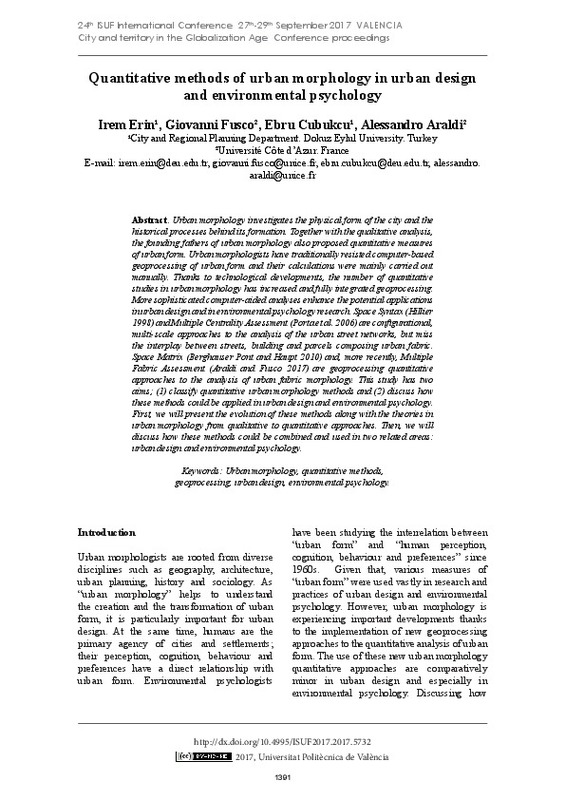JavaScript is disabled for your browser. Some features of this site may not work without it.
Buscar en RiuNet
Listar
Mi cuenta
Estadísticas
Ayuda RiuNet
Admin. UPV
Quantitative Methods of Urban Morphology in Urban Design and Environmental Psychology
Mostrar el registro sencillo del ítem
Ficheros en el ítem
| dc.contributor.author | Erin, Irem
|
es_ES |
| dc.contributor.author | Fusco, Giovanni
|
es_ES |
| dc.contributor.author | Cubukcu, Ebru
|
es_ES |
| dc.contributor.author | Araldi, Alessandro
|
es_ES |
| dc.date.accessioned | 2018-12-14T08:29:27Z | |
| dc.date.available | 2018-12-14T08:29:27Z | |
| dc.date.issued | 2018-04-20 | |
| dc.identifier.isbn | 9788490485743 | |
| dc.identifier.uri | http://hdl.handle.net/10251/113755 | |
| dc.description.abstract | [EN] Urban morphology investigates the physical form of the city and the historical processes behind its formation. Together with the qualitative analysis, the founding fathers of urban morphology also proposed quantitative measures of urban form. Urban morphologists have traditionally resisted computer-based geoprocessing of urban form and their calculations were mainly carried out manually. Thanks to technological developments, the number of quantitative studies in urban morphology has increased and fully integrated geoprocessing. More sophisticated computer-aided analyses enhance the potential applications in urban design and in environmental psychology research. Space Syntax (Hillier 1998) and Multiple Centrality Assessment (Porta et al. 2006) are configurational, multi-scale approaches to the analysis of the urban street networks, but miss the interplay between streets, building and parcels composing urban fabric. Space Matrix (Berghauser Pont and Haupt 2010) and, more recently, Multiple Fabric Assessment (Araldi and Fusco 2017) are geoprocessing quantitative approaches to the analysis of urban fabric morphology. This study has two aims; (1) classify quantitative urban morphology methods and (2) discuss how these methods could be applied in urban design and environmental psychology. First, we will present the evolution of these methods along with the theories in urban morphology from qualitative to quantitative approaches. Then, we will discuss how these methods could be combined and used in two related areas: urban design and environmental psychology. | es_ES |
| dc.format.extent | 10 | es_ES |
| dc.language | Inglés | es_ES |
| dc.publisher | Editorial Universitat Politècnica de València | es_ES |
| dc.relation.ispartof | 24th ISUF International Conference. Book of Papers | es_ES |
| dc.rights | Reconocimiento - No comercial - Sin obra derivada (by-nc-nd) | es_ES |
| dc.subject | Urban morphology | es_ES |
| dc.subject | Quantitative methods | es_ES |
| dc.subject | Geoprocessing | es_ES |
| dc.subject | Urban design | es_ES |
| dc.subject | Environmental psychology | es_ES |
| dc.title | Quantitative Methods of Urban Morphology in Urban Design and Environmental Psychology | es_ES |
| dc.type | Capítulo de libro | es_ES |
| dc.type | Comunicación en congreso | es_ES |
| dc.identifier.doi | 10.4995/ISUF2017.2017.5732 | |
| dc.rights.accessRights | Abierto | es_ES |
| dc.description.bibliographicCitation | Erin, I.; Fusco, G.; Cubukcu, E.; Araldi, A. (2018). Quantitative Methods of Urban Morphology in Urban Design and Environmental Psychology. En 24th ISUF International Conference. Book of Papers. Editorial Universitat Politècnica de València. 1391-1400. https://doi.org/10.4995/ISUF2017.2017.5732 | es_ES |
| dc.description.accrualMethod | OCS | es_ES |
| dc.relation.conferencename | 24th ISUF 2017 - City and Territory in the Globalization Age | es_ES |
| dc.relation.conferencedate | Septiembre 27-29,2017 | es_ES |
| dc.relation.conferenceplace | Valencia, Spain | es_ES |
| dc.relation.publisherversion | http://ocs.editorial.upv.es/index.php/ISUF/ISUF2017/paper/view/5732 | es_ES |
| dc.description.upvformatpinicio | 1391 | es_ES |
| dc.description.upvformatpfin | 1400 | es_ES |
| dc.type.version | info:eu-repo/semantics/publishedVersion | es_ES |
| dc.relation.pasarela | OCS\5732 | es_ES |








